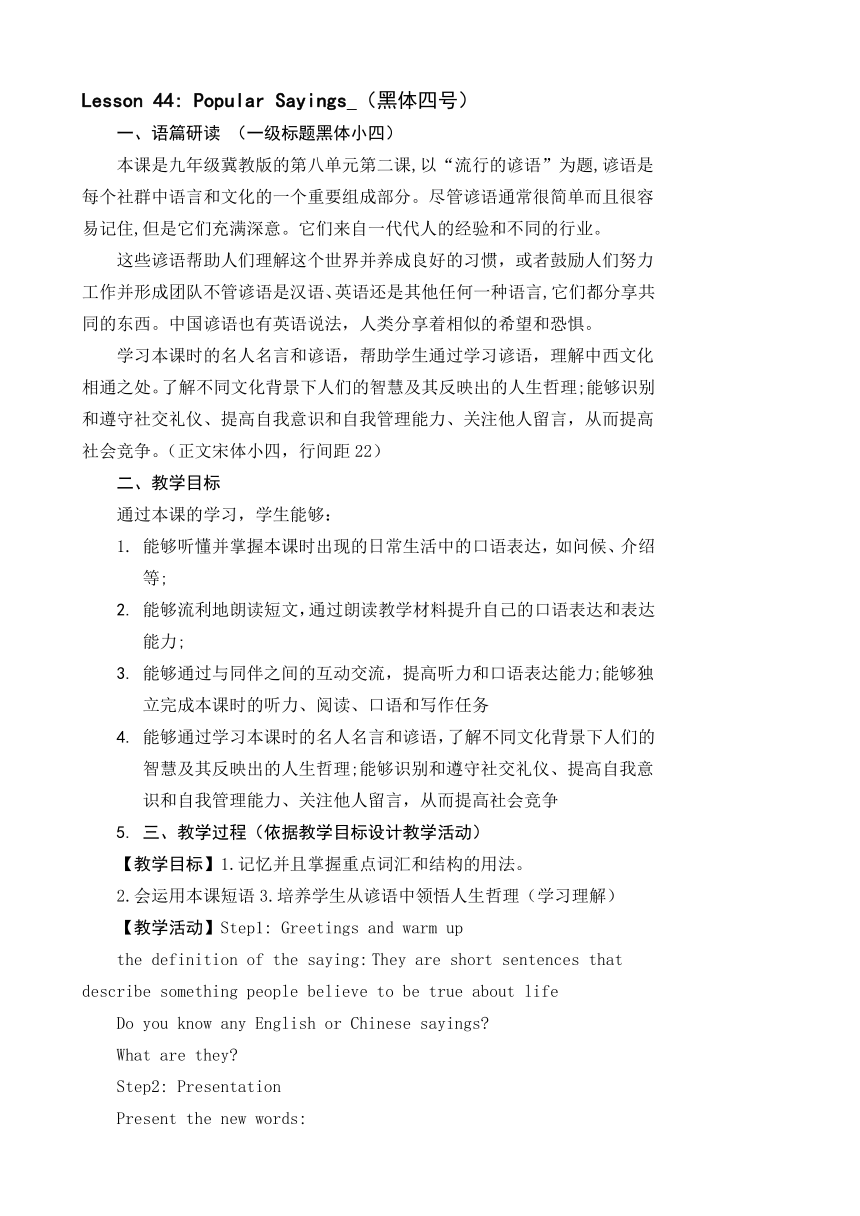Unit 8Lesson 44 Popular Sayings 教学设计 2023-2024学年冀教版九年级英语全册
文档属性
| 名称 | Unit 8Lesson 44 Popular Sayings 教学设计 2023-2024学年冀教版九年级英语全册 |  | |
| 格式 | docx | ||
| 文件大小 | 20.2KB | ||
| 资源类型 | 教案 | ||
| 版本资源 | 冀教版 | ||
| 科目 | 英语 | ||
| 更新时间 | 2023-09-27 22:05:40 | ||
图片预览

文档简介
Lesson 44: Popular Sayings (黑体四号)
一、语篇研读 (一级标题黑体小四)
本课是九年级冀教版的第八单元第二课,以“流行的谚语”为题,谚语是每个社群中语言和文化的一个重要组成部分。尽管谚语通常很简单而且很容易记住,但是它们充满深意。它们来自一代代人的经验和不同的行业。
这些谚语帮助人们理解这个世界并养成良好的习惯,或者鼓励人们努力工作并形成团队不管谚语是汉语、英语还是其他任何一种语言,它们都分享共同的东西。中国谚语也有英语说法,人类分享着相似的希望和恐惧。
学习本课时的名人名言和谚语,帮助学生通过学习谚语,理解中西文化相通之处。了解不同文化背景下人们的智慧及其反映出的人生哲理;能够识别和遵守社交礼仪、提高自我意识和自我管理能力、关注他人留言,从而提高社会竞争。(正文宋体小四,行间距22)
二、教学目标
通过本课的学习,学生能够:
能够听懂并掌握本课时出现的日常生活中的口语表达,如问候、介绍等;
能够流利地朗读短文,通过朗读教学材料提升自己的口语表达和表达能力;
能够通过与同伴之间的互动交流,提高听力和口语表达能力;能够独立完成本课时的听力、阅读、口语和写作任务
能够通过学习本课时的名人名言和谚语,了解不同文化背景下人们的智慧及其反映出的人生哲理;能够识别和遵守社交礼仪、提高自我意识和自我管理能力、关注他人留言,从而提高社会竞争
三、教学过程(依据教学目标设计教学活动)
【教学目标】1.记忆并且掌握重点词汇和结构的用法。
2.会运用本课短语3.培养学生从谚语中领悟人生哲理(学习理解)
【教学活动】Step1: Greetings and warm up
the definition of the saying: They are short sentences that describe something people believe to be true about life
Do you know any English or Chinese sayings
What are they
Step2: Presentation
Present the new words:
1. society n. 社会 2. generation n. 一代(人)
3. wealthy adj. 富有的;富裕的 4. penny n. 便士
5. pound n. 镑 6. foolish adj. 愚蠢的;傻的
7. whether conj. 是否;无论 8. human n./adj. 人类(的)
Step3: Listening & Reading
Read the Chinese sayings below and find the matching English expressions from the lesson
Step5: Production (Project)
Fill in the blanks using the sayings from the lesson.
Step6: the PPT, let students do the project.
☆教材解读☆
1.Seeing is believing.
本句中的Seeing与believing都是动名词,Seeing在句中作主语,believing在句中作表语。动名词还可在句中作宾语。
【拓展】 Seeing is believing.也可以表达为To see is to believe.,但是主语与表语的形式要一致,要么都用动名词,要么都用动词不定式。
2.An apple a day keeps the doctor away.
keep…away意为“使……远离”。 keep away from意为“远离”。
3.Although sayings are usually simple and easy to remember,they are full of deep meaning.
短语be full of与be filled with同义,意为“充满,装满”。
4.They come from the experience of generations
of people,and from different walks of life.
walk在本句中意为“活动领域,地位;职业”,people from/in different/all walks of life的意思是“各界人士”。
5.Early to bed and early to rise makes a man healthy,wealthy and wise.
本句的主语是由and连接的两个动词不定式短语,被视为一个概念,所以谓语动词用单数形式,如果表示两个概念,谓语动词要用复数形式。
6.A journey of a thousand miles begins with a single step.
begin with意为“以……开始;以
……为起点”,其反义短语为end in,意为“结束于……,以……告终”。
7.Well begun is half done.
本句是省略句,补全后是:That it is well begun is that it is half done.。
8.Don’t be penny wise and pound foolish.
9.Actions speak louder than words.
◆action在此处为可数名词,意为“所做之事,行动
Step7:Work in pairs.Discuss the meanings of the following sayings.Can you find the matching Chinese sayings Then make sentences with the sayings you have learned.
·When in Rome,do as the Romans do.
·First come,first served.
·It is never too late to mend.
·No pain,no gain.
【效果评价】师将对话改编为短文,使学生在充分理解文章的基础上填空,以此来训练学生的思维能力。进而将前面点明的三个方面的中西方文化差异以思维导图的形式总结下来,指出“文化塑造我们”这一单元主题。
【设计意图】导入主题,创设情境,激发学生参与的兴趣,激活学生关于谚语的提前准备;通过预测任务引导学生思考,培养学生利用情境线索进行推断预测的能力;帮助学生整体感知对话内容,并培养学生准确获取、梳理和记录关键信息的能力。(感知与注意、获取与梳理)
板书设计
五、作业设计
1.巩固性作业(必做),课时作业,完成时长10分钟;
Recite the new words and phrases and Sayings
2.拓展性作业(必做),课时作业,完成时长15分钟;
Finish Lesson 44 in the exercise book
3.探究性作业(选做),可设置为单元作业。
Write down a report about the cultural differences and the same things between the two countries.
六、教学反思
一、语篇研读 (一级标题黑体小四)
本课是九年级冀教版的第八单元第二课,以“流行的谚语”为题,谚语是每个社群中语言和文化的一个重要组成部分。尽管谚语通常很简单而且很容易记住,但是它们充满深意。它们来自一代代人的经验和不同的行业。
这些谚语帮助人们理解这个世界并养成良好的习惯,或者鼓励人们努力工作并形成团队不管谚语是汉语、英语还是其他任何一种语言,它们都分享共同的东西。中国谚语也有英语说法,人类分享着相似的希望和恐惧。
学习本课时的名人名言和谚语,帮助学生通过学习谚语,理解中西文化相通之处。了解不同文化背景下人们的智慧及其反映出的人生哲理;能够识别和遵守社交礼仪、提高自我意识和自我管理能力、关注他人留言,从而提高社会竞争。(正文宋体小四,行间距22)
二、教学目标
通过本课的学习,学生能够:
能够听懂并掌握本课时出现的日常生活中的口语表达,如问候、介绍等;
能够流利地朗读短文,通过朗读教学材料提升自己的口语表达和表达能力;
能够通过与同伴之间的互动交流,提高听力和口语表达能力;能够独立完成本课时的听力、阅读、口语和写作任务
能够通过学习本课时的名人名言和谚语,了解不同文化背景下人们的智慧及其反映出的人生哲理;能够识别和遵守社交礼仪、提高自我意识和自我管理能力、关注他人留言,从而提高社会竞争
三、教学过程(依据教学目标设计教学活动)
【教学目标】1.记忆并且掌握重点词汇和结构的用法。
2.会运用本课短语3.培养学生从谚语中领悟人生哲理(学习理解)
【教学活动】Step1: Greetings and warm up
the definition of the saying: They are short sentences that describe something people believe to be true about life
Do you know any English or Chinese sayings
What are they
Step2: Presentation
Present the new words:
1. society n. 社会 2. generation n. 一代(人)
3. wealthy adj. 富有的;富裕的 4. penny n. 便士
5. pound n. 镑 6. foolish adj. 愚蠢的;傻的
7. whether conj. 是否;无论 8. human n./adj. 人类(的)
Step3: Listening & Reading
Read the Chinese sayings below and find the matching English expressions from the lesson
Step5: Production (Project)
Fill in the blanks using the sayings from the lesson.
Step6: the PPT, let students do the project.
☆教材解读☆
1.Seeing is believing.
本句中的Seeing与believing都是动名词,Seeing在句中作主语,believing在句中作表语。动名词还可在句中作宾语。
【拓展】 Seeing is believing.也可以表达为To see is to believe.,但是主语与表语的形式要一致,要么都用动名词,要么都用动词不定式。
2.An apple a day keeps the doctor away.
keep…away意为“使……远离”。 keep away from意为“远离”。
3.Although sayings are usually simple and easy to remember,they are full of deep meaning.
短语be full of与be filled with同义,意为“充满,装满”。
4.They come from the experience of generations
of people,and from different walks of life.
walk在本句中意为“活动领域,地位;职业”,people from/in different/all walks of life的意思是“各界人士”。
5.Early to bed and early to rise makes a man healthy,wealthy and wise.
本句的主语是由and连接的两个动词不定式短语,被视为一个概念,所以谓语动词用单数形式,如果表示两个概念,谓语动词要用复数形式。
6.A journey of a thousand miles begins with a single step.
begin with意为“以……开始;以
……为起点”,其反义短语为end in,意为“结束于……,以……告终”。
7.Well begun is half done.
本句是省略句,补全后是:That it is well begun is that it is half done.。
8.Don’t be penny wise and pound foolish.
9.Actions speak louder than words.
◆action在此处为可数名词,意为“所做之事,行动
Step7:Work in pairs.Discuss the meanings of the following sayings.Can you find the matching Chinese sayings Then make sentences with the sayings you have learned.
·When in Rome,do as the Romans do.
·First come,first served.
·It is never too late to mend.
·No pain,no gain.
【效果评价】师将对话改编为短文,使学生在充分理解文章的基础上填空,以此来训练学生的思维能力。进而将前面点明的三个方面的中西方文化差异以思维导图的形式总结下来,指出“文化塑造我们”这一单元主题。
【设计意图】导入主题,创设情境,激发学生参与的兴趣,激活学生关于谚语的提前准备;通过预测任务引导学生思考,培养学生利用情境线索进行推断预测的能力;帮助学生整体感知对话内容,并培养学生准确获取、梳理和记录关键信息的能力。(感知与注意、获取与梳理)
板书设计
五、作业设计
1.巩固性作业(必做),课时作业,完成时长10分钟;
Recite the new words and phrases and Sayings
2.拓展性作业(必做),课时作业,完成时长15分钟;
Finish Lesson 44 in the exercise book
3.探究性作业(选做),可设置为单元作业。
Write down a report about the cultural differences and the same things between the two countries.
六、教学反思
同课章节目录
- Unit 7 Work for Peace
- Lesson 37 Don't Fight!
- Lesson 38 Making School a Better Place
- Lesson 39 The Dove and the Olive Branch
- Lesson 40 The UN—Power of Words
- Lesson 41 Jenny's Good Advice
- Lesson 42 Peace at Last
- Unit Review
- Unit 8 Culture Shapes Us
- Lesson 43 A Visit to Chinatown
- Lesson 44 Popular Sayings
- Lesson 45 Different Manners
- Lesson 46 Home to Many Cultures
- Lesson 47 Good Manners
- Lesson 48 Supper with the Bradshaws
- Unit Review
- Unit 9 Communication
- Lesson 49 Get Along with Others
- Lesson 50 Tips for Good Communication
- Lesson 51 What Could Be Wrong?
- Lesson 52 The Power of a Smile
- Lesson 53 Working in Groups
- Lesson 54 How Embarrassing!
- Unit Review
- Unit 10 Get Ready for the Future
- Lesson 55 Look into the Future
- Lesson 56 Manage Your Time
- Lesson 57 Best Wishes
- Lesson 58 Ms.Liu's Speech
- Lesson 59 Keep Your Choices Open
- Lesson 60 Get a Good Education
- Unit Review
